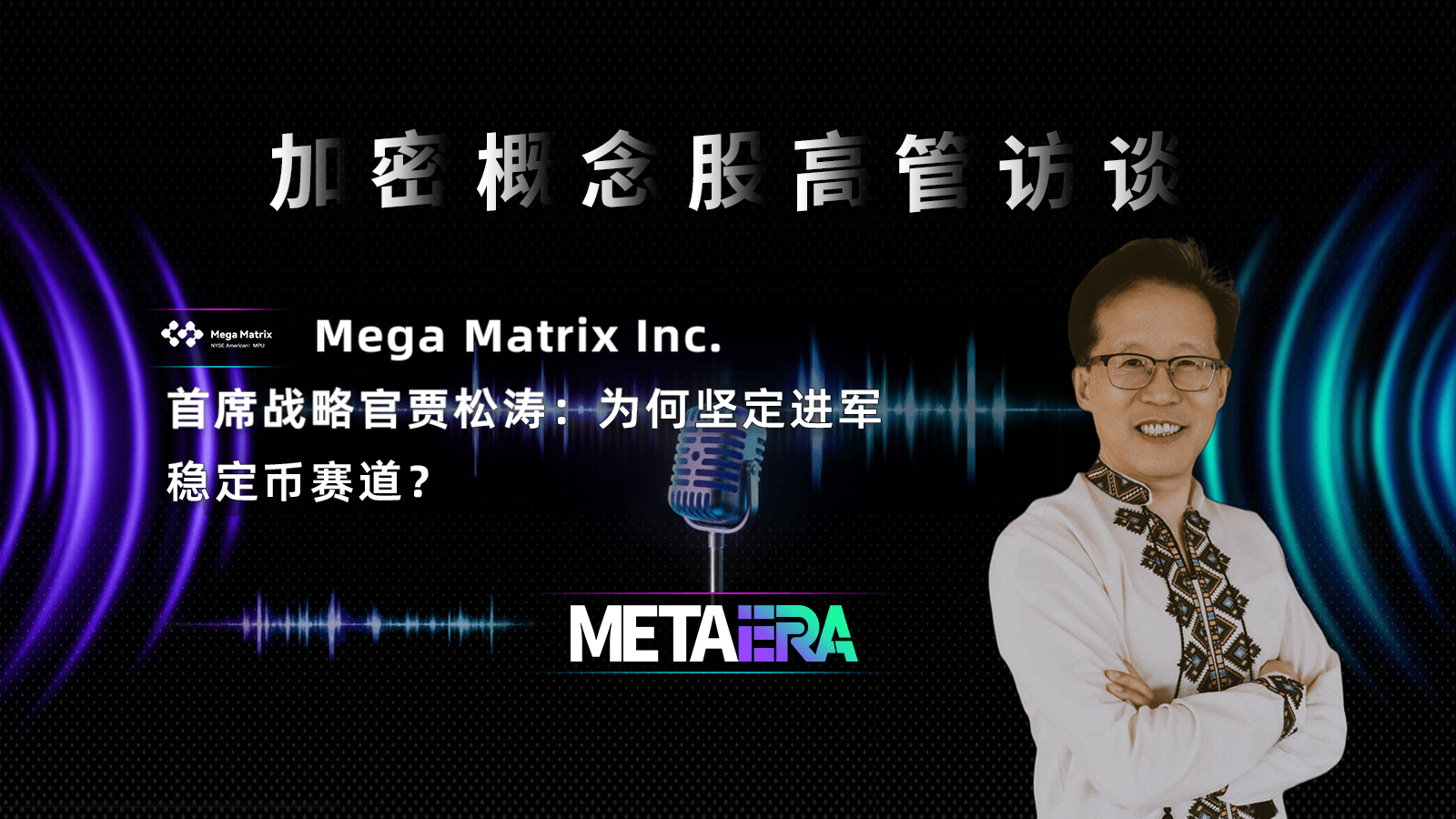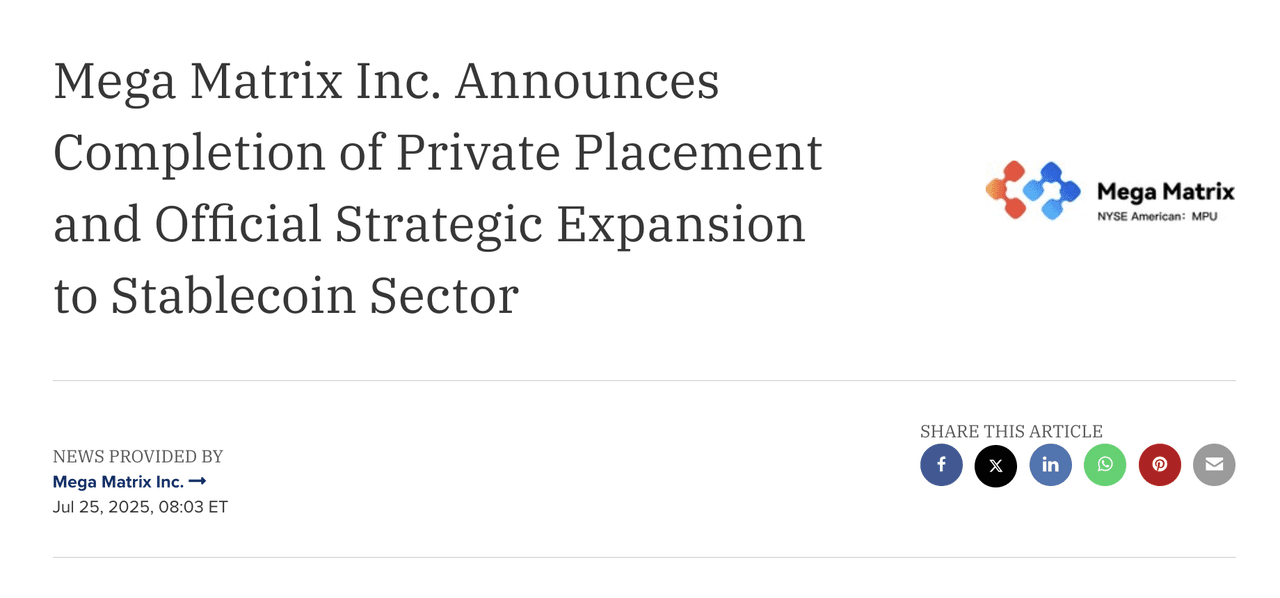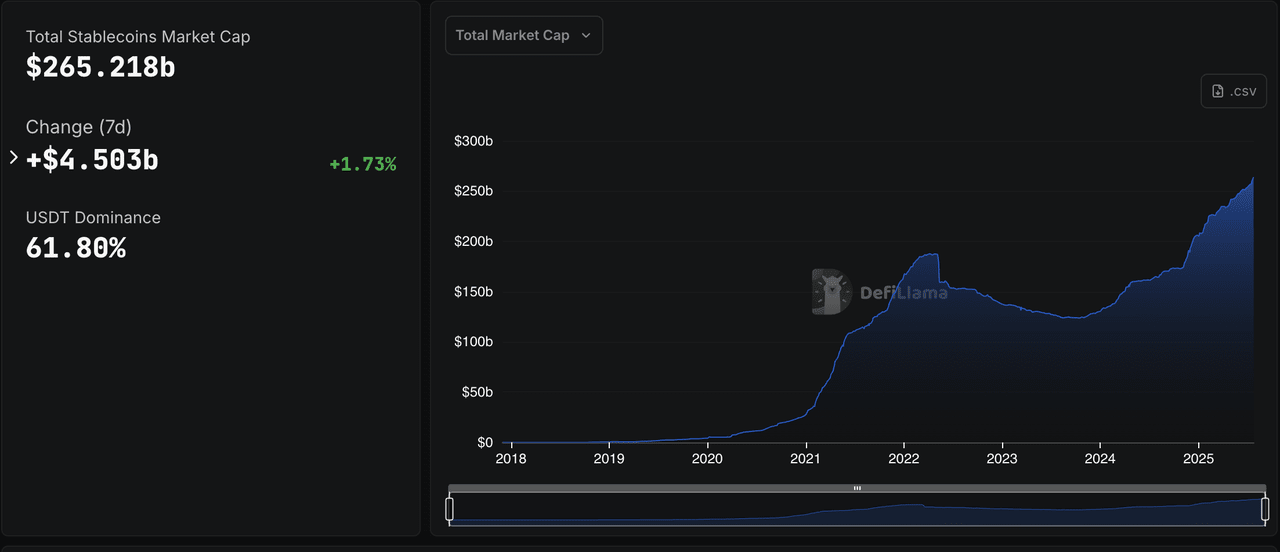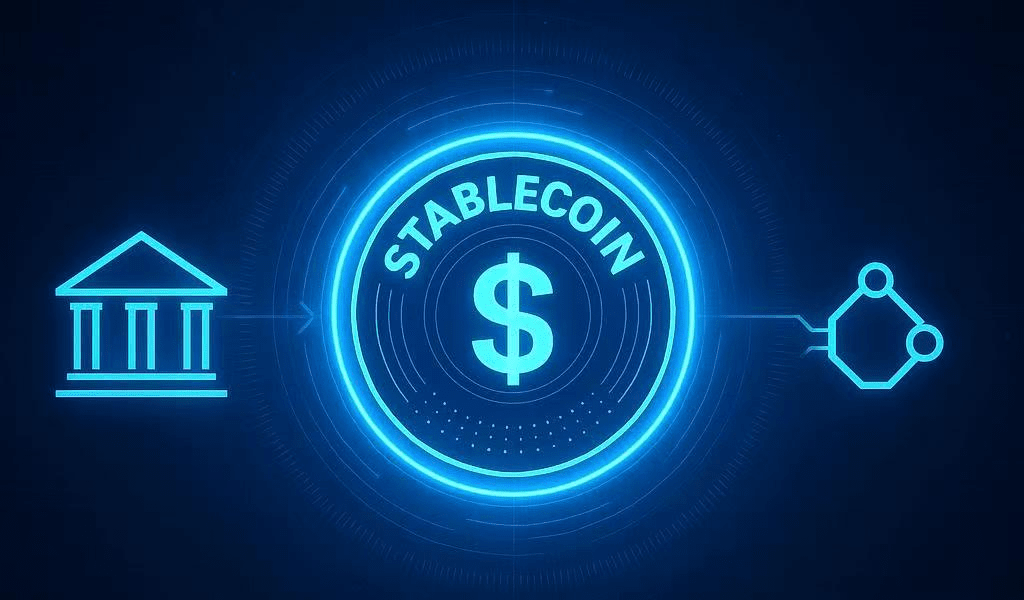In this interview, we talked with Jason Tao, Chief Strategy Officer of Mega Matrix Inc., focusing on why the company chose stablecoins as an entry point to systematically enter the field of on-chain finance and digital asset allocation.
Article Author: Lesley
Article Source: MetaEra
Core Views
• Stablecoins will not be a "phased product" but an important part of the long-term order of future digital assets and a bridge between the traditional financial system and the blockchain world.
• The next round of explosion will come from stablecoin treasury strategies, mainly because of the characteristics of stablecoins such as "low volatility, high compliance space, and strong composability."
• We believe that "compliant allocation + public yield" is not only a reflection of corporate responsibility but also a long-term commitment to the capital market and investor confidence.
The Web 3.0 strategy and layout of listed companies has become an increasingly popular topic of public concern. Against this background, MetaEra officially launched the "High-end Dialogue" interview series with executives of crypto concept stocks. We will talk to those corporate leaders who dare to take the lead in the wave of digital transformation, and through the first perspective of decision-makers, deeply explore their strategic layout, business innovation, and financial innovation to provide prospective insights for industry participants.

US-listed company Mega Matrix Inc. (NYSE: MPU) announced on July 25 that it had completed a private placement of US$16 million for stablecoin and governance token asset allocation. This marks Mega Matrix Inc.'s official entry into the core field of on-chain finance. Behind this financing, a number of cryptocurrency funds and top industry figures have gathered to support it, reflecting the market's high recognition of the digital transformation path of this traditional listed company.

From building the content ecosystem of the short drama streaming platform FlexTV to the current stablecoin asset allocation, Mega Matrix Inc.'s layout reflects a clear strategic plan for enterprises to embrace digital asset transformation.
"This private placement is a key step in our strategic upgrade," said Jason Tao, Chief Strategy Officer of the company, in an interview with MetaEra. "Mega Matrix Inc. has transformed from a holding company centered on content platforms to a systematic on-chain financial layout, especially focusing on stablecoin treasury strategies."
In this interview, we talked with Jason Tao, Chief Strategy Officer of Mega Matrix Inc., focusing on why the company chose stablecoins as an entry point to systematically enter the field of on-chain finance and digital asset allocation.
Why is Mega Matrix Inc. firmly betting on the stablecoin asset allocation track?
According to the announcement, Mega Matrix Inc.'s US$16 million private placement will be mainly used for the construction of a stablecoin asset allocation system and the design of an on-chain yield mechanism, focusing on the development of financial strategies related to stablecoins and governance tokens. This decision was not a whim.
"We researched this direction for a long time and also visited a large number of institutions and protocol parties before finally implementing it," Jason Tao admitted. "The market feedback for this strategic transformation has been very positive. Investors not only recognize Mega Matrix's execution capabilities but also have great confidence in the prospects of the stablecoin industry."
Stablecoins are standing on the eve of an explosion
Before explaining the specific strategic logic, Jason Tao first elaborated on the future judgment of the stablecoin industry from a macro level.
"I believe the future digital asset world will be built on three core infrastructures: public chains, stablecoins, and custody systems." In this framework, stablecoins will assume the complex functions of "asset anchoring + yield bearing + clearing carrier" and become the closest asset form to the "digital dollar."
This judgment is based on in-depth observation of the global digital asset development trend. From the accelerated advancement of central bank digital currencies (CBDC) to the acceptance of digital assets by traditional financial institutions and the reliance of the Web 3.0 ecosystem on stablecoins as basic liquidity, stablecoins are moving from the edge to the center of the world.
"We see that more and more sovereign countries, traditional financial institutions, and Web 3.0 projects are beginning to use stablecoins as part of the underlying liquidity structure." Jason Tao pointed out that from this perspective, stablecoins will not be a "phased product" but an important part of the long-term order of future digital assets.
More importantly, the gradual clarification of the regulatory environment is injecting unprecedented certainty into the stablecoin industry. The GENIUS Act (commonly known as the "Genius Act") just passed in the United States has opened a clear channel for stablecoin legislation, the MiCA regulatory framework in Europe has taken effect, and Hong Kong, Singapore, and other places are also accelerating the construction of their own stablecoin regulatory rules.

According to industry statistics, the global stablecoin market value has jumped from approximately US$5 billion in early 2020 to more than US$260 billion currently, an increase of more than 50 times. And with the improvement of the regulatory system and the expansion of actual application scenarios, this number is still rising rapidly.
"The entire stablecoin industry is moving from a gray area to institutionalization, and this is the eve of an explosion," Jason Tao judged.
The core logic of stablecoin asset allocation
Based on the judgment of the development prospects of the stablecoin industry, Mega Matrix Inc. further chose "stablecoin asset allocation" as the entry direction for its digital strategic transformation. Jason Tao pointed out that this choice stems from in-depth thinking about the trend of corporate financial structure digitization.

"Stablecoin asset allocation actually corresponds to a broader concept - Treasury Strategy." From the practice of market pioneers, different types of digital assets are forming their respective treasury strategies. Jason Tao introduced, "Companies like Strategy (NASDAQ: MSTR) use a Bitcoin treasury strategy, taking Bitcoin as a long-term core asset allocation on the company's balance sheet." Strategy uses the value storage function of "digital gold" to counter inflation risks, which has brought significant book profits and has also triggered imitation by other listed companies.
"Now we also see more and more companies adopting Ethereum-centered treasury strategies, and representative companies include SharpLink Gaming (NASDAQ: SBET), etc." Jason Tao added that these companies have formed a new liquidity infrastructure based on Ethereum's powerful ecological linkage capabilities and smart contract composability.
But in his judgment, the next round of explosion will come from stablecoin treasury strategies. The core logic of this judgment lies in the unique advantages of stablecoins:
• Low volatility: Compared to the high volatility of Bitcoin and Ethereum, stablecoins can provide companies with a relatively stable value base and reduce financial risks.
• Large compliance space: In the current regulatory environment, stablecoins have clearer compliance paths than other crypto assets and are more easily accepted by traditional financial institutions and regulatory authorities.
• Strong composability: Stablecoins have extremely strong composability and can generate actual returns through various protocols. In the current interest rate environment, the on-chain yield carried by high-quality stablecoins will become a scarce asset.
Jason Tao especially emphasized the advantage of "composability." The low interest rate environment in traditional financial markets makes high-quality yield assets extremely precious, and the yield generated by stablecoins through on-chain protocols just fills this gap. "So our allocation is not just the stablecoin itself, but the on-chain yield capability of the stablecoin."
The core of Mega Matrix Inc.'s strategy is: not simply holding stablecoins, but building a stablecoin asset allocation system that can continuously generate income.
From the perspective of industry development, stablecoin asset allocation is becoming an important bridge connecting the traditional financial and DeFi worlds. For traditional listed companies like Mega Matrix Inc., this strategy not only means asset allocation upgrades under controllable risks but also a strategic move to actively embrace digital financial infrastructure.
How does Mega Matrix Inc. build a stablecoin asset layout?
After determining the strategic direction, how to transform the concept into an executable business layout has become a key challenge facing Mega Matrix Inc. The competition in the stablecoin track ultimately competes on the ability to build an ecological network.
Cooperative layout: Deeply bind with mainstream stablecoin platforms
When asked about the specific progress of cooperation, Jason Tao revealed some important information, although he could not disclose the specific partner names for business confidentiality reasons.
"Currently, we are establishing in-depth cooperative relationships with several of the world's leading stablecoin issuers," Jason Tao said, "From the perspective of market value, leading stablecoins in the world include USDT, USDC, USDe, DAI, etc. These stablecoins have high market liquidity." In the stablecoin market, the head effect is extremely obvious. The top stablecoins occupy most of the market share and have relatively complete technical infrastructure and the widest ecological support.
"It can be confirmed that we are in substantial cooperation negotiations with at least two of the top five global stablecoin platforms," Jason Tao further revealed, "The cooperation content covers multiple directions such as asset allocation and on-chain yield integration." Mega Matrix Inc.'s cooperation idea is not simply asset purchase but to build a deeper level of business synergy. Asset allocation solves the problem of "what to buy," while on-chain yield integration involves the problem of "how to use it." This full-chain cooperation model is expected to bring more stable and sustainable sources of income to the company.
Market Analysis: Competitive Landscape of Mainstream Stablecoins
As a decision-maker of a company transforming to the stablecoin asset allocation track, Jason Tao has in-depth observations and unique insights on the characteristics and development prospects of current mainstream stablecoins. "From the current market value and industry consensus, the top-ranked stablecoins in the world mainly include USDT, USDC, DAI, and USDe. They each have their own characteristics and represent different development paths and ecological tendencies."
USDT: Market leading but compliance unresolved
As a pioneer in the stablecoin market, USDT has long held the top position among global stablecoins due to its first-mover advantage, circulating volume, and cross-border payment scenarios, said Jason Tao. But what will truly determine its fate in the future is its compliance capabilities. "With the gradual implementation of global stablecoin legislation, USDT still needs to make further responses in terms of compliance and transparency."
USDC: Obvious compliance advantages, limited yield capabilities
In contrast, USDC stands out in terms of compliance. Jason Tao said, "USDC is widely recognized by traditional financial institutions for its high compliance and audit transparency. The GENIUS Act recently passed in the United States can be said to be tailor-made for USDC to a certain extent, making it a key interface between traditional finance and blockchain finance." However, in addition to compliance advantages, USDC also has obvious functional limitations: "It should be pointed out that USDC itself does not provide on-chain yields to holders."
USDe: Innovative Yield Model Helps It Rise Rapidly
Jason Tao also paid special attention to USDe, which has risen rapidly in recent years. "USDe is one of the fastest-growing stablecoins in recent years, and its underlying on-chain yield mechanism sUSDe brings new asset allocation possibilities." With the rapid increase in market demand for "yield-bearing stablecoins," USDe's growth path presents a differentiated paradigm.
DAI: Representative of decentralized stablecoins
As a representative of decentralized stablecoins, DAI occupies a special position in Jason Tao's analysis. "DAI, as a representative of decentralized stablecoins, occupies a central position in the DeFi ecosystem and is suitable for forming strategic synergies with other decentralized protocols."
It can be seen from the above analysis that Mega Matrix Inc.'s consideration factors in stablecoin selection are very comprehensive: it must consider market position and liquidity, but also pay attention to compliance and yield capabilities, and also evaluate the possibility of ecological synergy. This multi-dimensional analysis framework provides clear guiding principles for the company's subsequent specific cooperation decisions.
Transparent Disclosure: Creating a New Benchmark for Web 3.0 Finance
At a time when digital assets are gradually becoming an important part of corporate financial allocation, how to achieve transparent disclosure within the compliance framework has become a core issue that traditional listed companies must face when entering the Web 3.0 field. Mega Matrix Inc., as a listed company that entered this field earlier, its exploration in financial disclosure and compliance mechanisms may provide an important reference sample for the entire industry.
When asked whether stablecoin asset allocation income would be included in the financial report disclosure system, Jason Tao said that this is a matter that the company attaches great importance to and gave a clear and specific response.
"As a listed company, Mega Matrix Inc. is building a set of auditable and disclosable financial record system while promoting stablecoin asset allocation," Jason Tao emphasized that the construction of this system is advanced in parallel with business development to ensure compliance with the requirements of listed companies from the beginning. "We believe that 'compliant allocation + public yield' is not only a reflection of corporate responsibility but also a long-term commitment to the capital market and investor confidence," Jason Tao concluded.
The significance of this practice lies not only in meeting regulatory requirements but also in establishing an important precedent for the industry. Compared to many companies still exploring how to handle digital asset accounting issues, Mega Matrix Inc.'s proactive approach is particularly valuable.
Summary: Traditional Capital Embraces the New Paradigm of Web 3.0
At the moment when digital assets are becoming institutionalized, Mega Matrix Inc.'s strategic transformation is not only a business restructuring but also an active attempt by a listed company to redefine its role boundary among capital, compliance, and technology. It did not choose the most noisy concept but integrated Web 3.0 into the skeleton of the corporate treasury, gradually establishing a controllable, auditable, and interest-bearing stablecoin asset system.
For more companies in traditional industries, this may provide a realistic and replicable paradigm—not "All in Crypto," but "All in Strategy." Mega Matrix Inc.'s choice is not an isolated case but may be a harbinger: more and more companies are moving towards an era of stable returns, transparent structures, and systematic integration of on-chain financial tools.
In the new order of Web 3.0, only those who take the lead in implementation can seize the starting line for competitive advantage.
Stablecoins are not the end point of a certain industry trend but the starting point of a comprehensive reshaping of the underlying financial structure. Those platforms that take the lead in completing the integration of institutional docking, yield models, and on-chain allocation capabilities will become the backbone of the future digital financial ecosystem. Mega Matrix is taking the lead in this deep transformation and has completed the preliminary deployment of strategic positioning and resource landing points.

